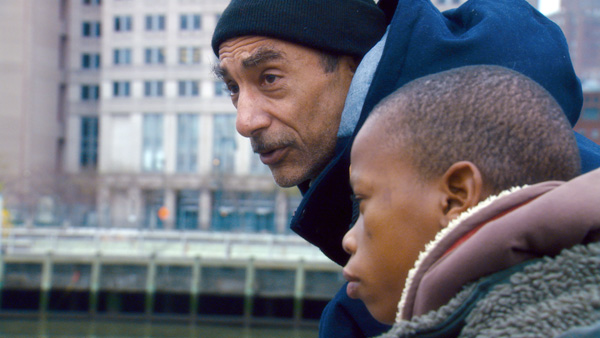As a young man, Louis Sarno loved classical music, being especially drawn to compositions rich in polyphony. He discovered a similar harmonization present in the music of pygmy tribes, and he became obsessed with hearing it firsthand and understanding its origins. In 1985, he traveled to the rainforests of the Central African Republic, where he found a village of the Bayaka people. Here he would eventually marry, have a son, and, as the first ethnomusicologist to become completely immersed in their hunter-gatherer society, make countless recordings of their music.
Through a mixture of interviews and candid footage, director Michael Obert provides a limited portrait of Sarno; documents Sarno’s return visit to America with his 13-year-old son, Samedi; and includes numerous glimpses into a Bayaka village and the increasing threats to their way of life. Portions of the documentary, as well as its promotional website, make it clear that the film is, in part, a fund-raising effort for the Bayaka, but it offers little in the way of an emotional appeal. Obert introduces three distinct stories, yet fails to adequately develop any of them. The result is a mixed bag that at times seems at cross purposes with itself, and while some of the content is certainly of historical significance, as a whole the film raises far more questions than it attempts to answer.
Sarno has not tried to teach the Bayaka, including his wife and son, to read or speak English, and seems generally opposed to introducing Western influences on their culture. He is actively engaged in trying to stop the poaching and deforestation that is severely hampering their ability to hunt for food (they use only handwoven nets). However, Sarno does not physically join in the effort to procure food for the village. He serves the community by using the money he makes from sales of his recordings to purchase medicine and material goods that would otherwise be difficult, if not impossible, for the Bayaka to obtain on their own, and they have become reliant on Sarno to provide these products.
Sarno reluctantly makes a return visit to America, and he only takes Samedi along because of a promise he made years before when the boy was suffering a life-threatening illness. Once in New York, the cultural gulf that exists between father and son is suddenly made evident. Sarno’s demeanor shifts dramatically from relaxed contentment to visible stress. The poor state of his health becomes obvious, and he frets over his rapidly dwindling funds. He appears to develop behavioral expectations of Samedi, snaps at him for not wanting to eat American food, and purchases a quantity of children’s toys inappropriate for Samedi’s 13 years. For his part, Samedi is outspoken about the waste of buying toys when what he and his people need are guns for hunting, clothing, and food.
There is an underlying, yet obvious mixed message that vacillates between the importance of maintaining what’s left of an ancient culture and the unavoidable conclusion that there has already been so much exposure to outside influences that adaptation is now required for survival.
Two unifying elements make this documentary worth watching. First is the soundtrack. Providing an appropriate backdrop, it is an inspired combination of Bayaka songs and drumming incorporating the ever-present sounds of the rainforest, interspersed with selections from William Byrd’s Mass for Four Voices.
Second is Siri Klug’s brilliant cinematography. From the moisture rich, verdant undergrowth of the rainforest floor, the film opens on a diaphanous veil of water droplets, and the camera tilts up toward the canopy of trees, with shafts of sunlight piercing through. By contrast, New York City is viewed from skyscraper windows that look down on a cold, gray concrete geometry where people scurry about like ants. Klug’s camera captures emotion in rainforest and cityscape that is largely unexpressed by the limited dialogue.
Together, the soundtrack and the cinematography bring a much needed spiritual essence to the film, making it a viable vehicle for highlighting Sarno’s valuable contribution toward preserving the Bayaka’s cultural heritage.







Leave A Comment